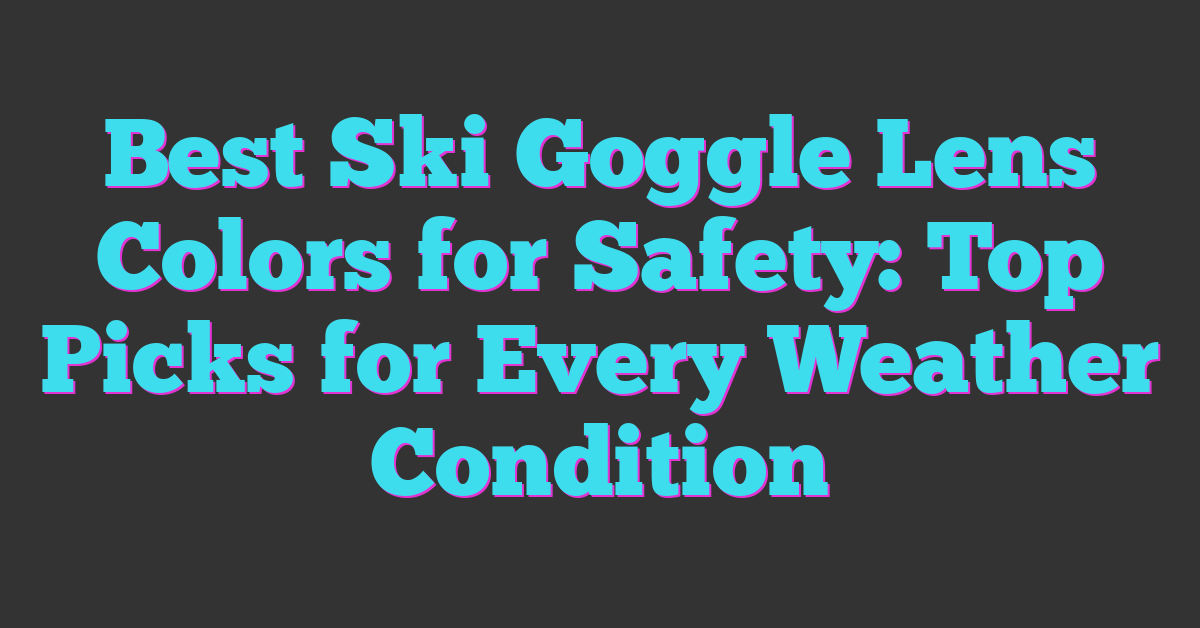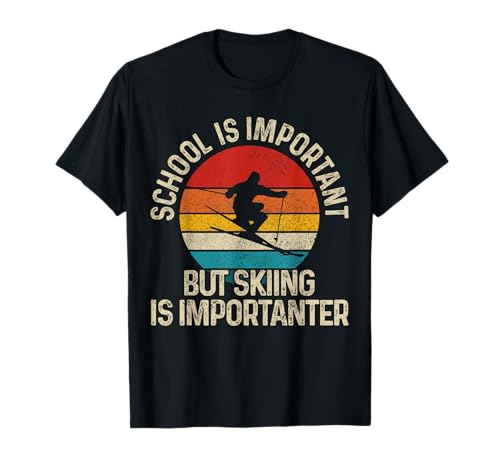When I hit the slopes, I know how important it is to see clearly in every kind of weather. The right ski goggle lens color can make all the difference, not just for visibility but also for staying safe. Whether it’s a sunny day or a snowstorm, your lens choice can help you spot changes in terrain and avoid unexpected obstacles.

I’ve learned that not all lens colors are created equal—some are perfect for bright, sunny days, while others are designed to enhance contrast in low-light or foggy conditions. Picking the right one isn’t just about style; it’s about making sure you’re prepared for whatever the mountain throws your way. Let’s dive into which colors work best for safety and why they matter so much.
Importance Of Choosing The Right Ski Goggle Lens
As someone who spends countless hours on the slopes, I know the critical role a ski goggle lens plays in both safety and performance. The right lens enhances visibility, letting me clearly see changes in terrain and obstacles that could otherwise catch me off guard. Whether it’s thick fog rolling in or blinding sunlight bouncing off fresh powder, the lens color directly impacts how well I can read the environment.
Poor visibility on the mountain doesn’t just affect my enjoyment; it increases the risk of accidents. Flat light conditions, for example, can make it nearly impossible to discern bumps or dips in the snow. Using the right lens tint designed for low light, like yellow or amber, boosts contrast and adds definition to the terrain. On bluebird days, darker tints with mirror coatings reduce glare and prevent eye strain from UV rays.
Weather changes quickly in the mountains, so it’s crucial for my goggles to adapt. Interchangeable lenses allow me to switch between tints depending on the conditions. That flexibility ensures I stay prepared, whether I’m navigating shadows in the trees or riding under a cloudless sky. For me, choosing the right lens isn’t just about comfort—it’s about skiing smarter and staying safe in any situation.
Key Features To Consider For Safety
As someone who lives for winter sports, I know firsthand how essential it is to pick goggles with the right safety features. A good pair doesn’t just enhance your vision—it protects you in the most challenging conditions.
UV Protection
Protecting my eyes from UV rays is non-negotiable when I’m out on the slopes. High-altitude environments amplify UV exposure, increasing the risk of snow blindness or long-term eye damage. Goggles with 100% UV protection block UVA and UVB rays, keeping my eyes safe whether it’s sunny or overcast. Lenses with mirrored or darker tints, like silver or gray, work well in bright sun, reducing glare and eye strain while offering all-day comfort.
Anti-Fog Coating
Few things are more frustrating than dealing with fogged-up lenses when flying down a run. Anti-fog coatings ensure my vision remains clear even when the temperature changes or I’m building up a sweat. Premium goggles often feature dual-lens systems and ventilation channels that combat fogging. For added effectiveness, I avoid wiping the inner lens, as this can damage the coating and reduce its performance.
Impact Resistance
High-speed descents and unexpected falls make impact resistance critical. I always choose goggles with polycarbonate or similar shatterproof materials that protect my eyes from debris, branches, or accidental collisions. These lenses are lightweight yet durable, giving me peace of mind without compromising comfort. When I hit tree-lined trails or park features, I trust that my goggles can handle whatever comes my way.
Overview Of Lens Colors And Their Uses
As someone who lives for snow sports, I know how critical it is to choose the right ski goggle lens color. Each lens color serves a specific purpose, helping to adapt to the changing light conditions on the mountain and enhancing safety.
Yellow/Gold Lenses
Yellow or gold lenses excel in low-light conditions. These colors boost contrast during overcast days or in heavy snow. Whenever I’m skiing in flat light or dense fog, I rely on yellow lenses to make out the terrain and avoid hidden obstacles.
Amber/Orange Lenses
Amber and orange lenses are versatile and work well in moderate to low-light conditions. They enhance depth perception and increase contrast, making them my go-to for mixed weather days when clouds and sun alternate. These lenses perform especially well in wooded areas where shadows can cause visibility challenges.
Clear Lenses
Clear lenses offer the best visibility at night or in extremely low-light conditions. They don’t filter color or light but protect against wind and debris while allowing maximum clarity. I always pack my clear lenses for night skiing or very cloudy days when natural light is limited.
Dark/Gray Lenses
Dark or gray lenses reduce brightness on sunny days. They distribute light evenly without distorting colors, ensuring a more comfortable experience on bright slopes. I lean on these lenses when the sun is strong, and glare off the snow makes it difficult to see.
Mirror/Reflective Lenses
Mirror or reflective lenses reduce glare and work best in bright, sunny conditions. The reflective coating bounces excessive light away from the eyes. Whenever conditions are bright and visibility is good, I prefer mirror lenses to reduce eye strain while enjoying crisp views of the slopes.
Best Lens Colors For Specific Weather Conditions
As someone who loves racing down the slopes, I know how crucial the right goggle lens color is for seeing clearly and staying safe. Different weather conditions demand different tints to ensure the best visibility on the mountain.
Sunny Days
For bright, sunny days that make the snow glisten, dark or gray lenses work best. These tints reduce overall light intensity without distorting colors, which keeps my vision natural and balanced. I often opt for mirror or reflective coatings on sunny days since they cut down on glare from the snow. This combination makes it easier to spot terrain details and avoid eye strain on clear bluebird days.
Overcast Or Cloudy Days
During overcast or snowy conditions when the light gets flat, I go for yellow or light gold lenses. These colors brighten the view and enhance contrast, helping me see bumps and variations in the terrain. Amber or orange lenses also work well for mixed weather since they improve depth perception in low-light settings. With these lenses, I can confidently navigate through changing visibility conditions, especially when the clouds roll in midway through a ski session.
Night Skiing
When I’m out under the lights for night skiing, clear lenses are my go-to. They offer maximum clarity, ensuring nothing hinders my visibility while still protecting my eyes from wind and debris. Without the need to block sunlight, clear lenses provide an unobstructed view, letting me focus on the joy of skiing under the stars.
Tips For Selecting The Perfect Goggle Lens
Choosing the right ski goggle lens goes beyond looks—it’s about performance and safety. As someone who loves spending every minute I can on the slopes, I’ve learned that finding the perfect lens can make or break a day in the snow.
Match Lens Color To Conditions
The weather decides the lens. For bright sunny days, I prefer dark or gray lenses with a mirror coating. They cut glare and keep colors true to life. During overcast days, yellow or light gold lenses boost contrast, making uneven terrain easier to spot. Clear lenses are my go-to for night skiing or heavy fog; they keep my vision sharp when light is scarce.
Prioritize UV Protection
High altitudes mean stronger UV rays. Goggles with 100% UV protection safeguard my eyes from snow blindness and long-term damage. Even on cloudy days, UV rays are intense, so I always double-check this feature.
Invest In Anti-Fog Coatings
Clear vision is key no matter the weather. Goggles with anti-fog coatings prevent condensation buildup, even during intense runs or changing temperatures. I avoid touching the inner lens to keep the coating working season after season.
Consider Interchangeable Lenses
Weather on the mountain changes fast. Interchangeable lenses save me the trouble of carrying extra goggles. With a quick swap, I’m ready for a sunny morning and a cloudy afternoon.
Check Fit and Comfort
A proper fit ensures safety. My goggles shouldn’t pinch or slide around, even when I’m pushing hard on the slopes. I make sure they’re compatible with my helmet, too, for gap-free protection.
Look For Shatterproof Materials
Impact resistance is non-negotiable. I rely on goggles with polycarbonate lenses to handle unexpected debris or falls. The durability brings peace of mind during intense runs and tricky terrain.
Great lenses elevate every run. By matching lens features to conditions, I always stay safe and fully enjoy my time on the mountain.
Conclusion
Choosing the right ski goggle lens color isn’t just about comfort—it’s about staying safe and performing your best on the slopes. The right lenses can make all the difference in visibility, whether you’re skiing under bright sunshine, cloudy skies, or in low light.
By prioritizing features like UV protection, anti-fog coatings, and impact resistance, you’re not only protecting your eyes but also enhancing your overall skiing experience. Don’t forget that interchangeable lenses can be a game-changer when the weather takes an unexpected turn.
With the right pair of goggles, you’ll feel confident tackling any terrain while keeping your eyes safe and your vision clear. Stay smart, stay safe, and enjoy every moment on the mountain!
















